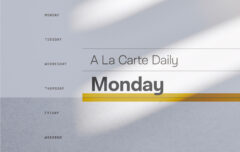Yesterday I posted a short story by Canadian humorist Stephen Leacock. Well, I thought it would be fun to post one more thing by him before turning to more important matters. The story by Leacock that is usually considered his most humorous is entitled “Arcadian Adventures With the Idle Rich.” As one commenter (who happens to be my mother) posted yesterday, some of the book is “devoted to contrasting an Anglican [Episcopalian] and Presbyterian church—and their respective ministers. Of course, it is a caricature, an absolutely brilliant one…A must- read for Reformed people wanting to laugh at themselves!” Here are two excerpts, one very short and the other a bit longer. If you are Reformed and/or Anglical and/or Presbyterian, you may recognize a caricature of yourself somewhere in here. Enjoy!
* * * * * *
Later on, when Spillikins went into business and into society, the same fate pursued him. He loved, for at least six months, Georgiana McTeague, the niece of the presbyterian minister of St. Osoph’s. He loved her so well that for her sake he temporarily abandoned his pew at St. Asaph’s, which was episcopalian, and listened to fourteen consecutive sermons on hell. But the affair got no further than that. Once or twice, indeed, Spillikins walked home with Georgiana from church and talked about hell with her; and once her uncle asked him into the manse for cold supper after evening service, and they had a long talk about hell all through the meal and upstairs in the sitting-room afterwards. But somehow Spillikins could get no further with it. He read up all he could about hell so as to be able to talk with Georgiana, but in the end it failed: a young minister fresh from college came and preached at St. Osoph’s six special sermons on the absolute certainty of eternal punishment, and he married Miss McTeague as a result of it.
* * * * * *
The church of St. Asaph, more properly call St. Asaph’s in the Fields, stands among the elm trees of Plutoria Avenue opposite the university, its tall spire pointing to the blue sky. Its rector is fond of saying that it seems to him to point, as it were, a warning against the sins of a commercial age. More particularly does he say this in his Lenten services at noonday, when the businessmen sit in front of him in rows, their bald heads uncovered and their faces stamped with contrition as they think of mergers that they should have made, and real estate that they failed to buy for lack of faith.
The ground on which St. Asaph’s stands is worth seven dollars and a half a foot. The mortgagees, as they kneel in prayer in their long frock-coats, feel that they have built upon a rock. It is a beautifully appointed church. There are windows with priceless stained glass that were imported from Normandy, the rector himself swearing out the invoices to save the congregation the grievous burden of the customs duty. There is a pipe organ in the transept that cost ten thousand dollars to install. The debenture-holders, as they join in the morning anthem, love to hear the dulcet notes of the great organ and to reflect that it is as good as new. Just behind the church is St. Asaph’s Sunday School, with a ten-thousand dollar mortgage of its own. And below that again on the side street, is the building of the Young Men’s Guild with a bowling-alley and a swimming-bath deep enough to drown two young men at a time, and a billiard-room with seven tables. It is the rector’s boast that with a Guild House such as that there is no need for any young man of the congregation to frequent a saloon. Nor is there.
And on Sunday mornings, when the great organ plays, and the mortgagees and the bond-holders and the debenture-holders and the Sunday school teachers and the billiard-markers all lift up their voices together, there is emitted from St. Asaph’s a volume of praise that is practically as fine and effective as paid professional work.
St. Asaph’s is episcopal. As a consequence it has in it and about it all those things which go to make up the episcopal church—brass tablets let into its walls, blackbirds singing in its elm trees, parishioners who dine at eight o’clock, and a rector who wears a little crucifix and dances the tango.
On the other hand, there stands upon the same street, not a hundred yards away, the rival church of St. Osoph—presbyterian down to its very foundations in bed-rock, thirty feet below the level of the avenue. It has a short, squat tower—and a low roof, and its narrow windows are glazed with frosted glass. It has dark spruce trees instead of elms, crows instead of blackbirds, and a gloomy minister with a shovel hat who lectures on philosophy on week-days at the university. He loves to think that his congregation are made of the lowly and the meek in spirit, and to reflect that, lowly and meek as they are, there are men among them that could buy out half the congregation of St. Asaph’s.
St. Osoph’s is only presbyterian in a special sense. It is, in fact, too presbyterian to be any longer connected with any other body whatsoever. It seceded some forty years ago from the original body to which it belonged, and later on, with three other churches, it seceded from the group of seceding congregations. Still later it fell into a difference with the three other churches on the question of eternal punishment, the word “eternal” not appearing to the elders of St. Osoph’s to designate a sufficiently long period. The dispute ended in a secession which left the church of St. Osoph practically isolated in a world of sin whose approaching fate it neither denied nor deplored.
In one respect the rival churches of Plutoria Avenue had had a similar history. Each of them had moved up by successive stages from the lower and poorer parts of the city. Forty years ago St. Asaph’s had been nothing more than a little frame church with a tin spire, away in the west of the slums, and St. Osoph’s a square, diminutive building away in the east. But the site of St. Asaph’s had been bought by a brewing company, and the trustees, shrewd men of business, themselves rising into wealth, had rebuilt it right in the track of the advancing tide of a real estate boom. The elders of St. Osoph, quiet men, but illumined by an inner light, had followed suit and moved their church right against the side of an expanding distillery. Thus both the churches, as decade followed decade, made their way up the slope of the City till St. Asaph’s was presently gloriously expropriated by the street railway company, and planted its spire in triumph on Plutoria Avenue itself. But St. Osoph’s followed. With each change of site it moved nearer and nearer to St. Asaph’s. Its elders were shrewd men. With each move of their church they took careful thought in the rebuilding. In the manufacturing district it was built with sixteen windows on each side and was converted at a huge profit into a bicycle factory. On the residential street it was made long and deep and was sold to a moving-picture company without the alteration of so much as a pew. As a last step a syndicate, formed among the members of the congregation themselves, bought ground on Plutoria Avenue, and sublet it to themselves as a site for the church, at a nominal interest of five per cent per annum, payable nominally every three months and secured by a nominal mortgage.
As the two churches moved, their congregations, or at least all that was best of them—such members as were sharing in the rising fortunes of the City—moved also, and now for some six or seven years the two churches and the two congregations had confronted one another among the elm trees of the Avenue opposite to the university.
But at this point the fortunes of the churches had diverged. St. Asaph’s was a brilliant success; St. Osoph’s was a failure. Even its own trustees couldn’t deny it. At a time when St. Asaph’s was not only paying its interest but showing a handsome surplus on everything it undertook, the church of St. Osoph was moving steadily backwards.
There was no doubt, of course, as to the cause. Everybody knew it. It was simply a question of men, and, as everybody said, one had only to compare the two men conducting the churches to see why one succeeded and the other failed.
The Reverend Edward Fareforth Furlong of St. Asaph’s was a man who threw his whole energy into his parish work. The subtleties of theological controversy he left to minds less active than his own. His creed was one of works rather than of words, and whatever he was doing he did it with his whole heart. Whether he was lunching at the Mausoleum Club with one of his church wardens, or playing the flute—which he played as only the episcopal clergy can play it—accompanied on the harp by one of the fairest of the ladies of his choir, or whether he was dancing the new episcopal tango with the younger daughters of the elder parishioners, he threw himself into it with all his might. He could drink tea more gracefully and play tennis better than any clergyman on this side of the Atlantic. He could stand beside the white stone font of St. Asaph’s in his long white surplice holding a white-robed infant, worth half a million dollars, looking as beautifully innocent as the child itself, and drawing from every matron of the congregation with unmarried daughters the despairing cry, “What a pity that he has no children of his own!”
Equally sound was his theology. No man was known to preach shorter sermons or to explain away the book of Genesis more agreeably than the rector of St. Asaph’s; and if he found it necessary to refer to the Deity he did so under the name of Jehovah or Jah, or even Yaweh in a manner calculated not to hurt the sensitiveness of any of the parishioners. People who would shudder at brutal talk of the older fashion about the wrath of God listened with well-bred interest to a sermon on the personal characteristics of Jah. In the same way Mr. Furlong always referred to the devil, not as Satan but as Su or Swa, which took all the sting out of him. Beelzebub he spoke of as Behel-Zawbab, which rendered him perfectly harmless. The Garden of Eden he spoke of as the Paradeisos, which explained it entirely; the flood as the Diluvium, which cleared it up completely; and Jonah he named, after the correct fashion Jon Nah, which put the whole situation (his being swallowed by Baloo or the Great Lizard) on a perfectly satisfactory footing. Hell itself was spoken of as She-ol, and it appeared that it was not a place of burning, but rather of what one might describe as moral torment. This settled She-ol once and for all: nobody minds moral torment. In short, there was nothing in the theological system of Mr. Furlong that need have occasioned in any of his congregation a moment’s discomfort.
There could be no greater contrast with Mr. Fareforth Furlong than the minister of St. Osoph’s, the Rev. Dr. McTeague, who was also honorary professor of philosophy at the university. The one was young, the other was old; the one could dance the other could not; the one moved about at church picnics and lawn teas among a bevy of disciples in pink and blue sashes; the other moped around under the trees of the university campus with blinking eyes that saw nothing and an abstracted mind that had spent fifty years in trying to reconcile Hegel with St. Paul, and was still busy with it. Mr. Furlong went forward with the times; Dr. McTeague slid quietly backwards with the centuries.
Dr. McTeague was a failure, and all his congregation knew it. “He is not up to date,” they said. That was his crowning sin. “He don’t go forward any,” said the business members of the congregation. “That old man believes just exactly the same sort of stuff now that he did forty years ago. What’s more, he preaches it. You can’t run a church that way, can you?”
His trustees had done their best to meet the difficulty. They had offered Dr. McTeague a two-years’ vacation to go and see the Holy Land. He refused; he said he could picture it. They reduced his salary by fifty per cent; he never noticed it. They offered him an assistant; but he shook his head, saying that he didn’t know where he could find a man to do just the work that he was doing. Meantime he mooned about among the trees concocting a mixture of St. Paul with Hegel, three parts to one, for his Sunday sermon, and one part to three for his Monday lecture.
No doubt it was his dual function that was to blame for his failure. And this, perhaps, was the fault of Dr. Boomer, the president of the university. Dr. Boomer, like all university presidents of today, belonged to the presbyterian church; or rather, to state it more correctly, he included presbyterianism within himself. He was of course, a member of the board of management of St. Osoph’s and it was he who had urged, very strongly, the appointment of Dr. McTeague, then senior professor of philosophy, as minister.
“A saintly man,” he said, “the very man for the post. If you should ask me whether he is entirely at home as a professor of philosophy on our staff at the university, I should be compelled to say no. We are forced to admit that as a lecturer he does not meet our views. He appears to find it difficult to keep religion out of his teaching. In fact, his lectures are suffused with a rather dangerous attempt at moral teaching which is apt to contaminate our students. But in the Church I should imagine that would be, if anything, an advantage. Indeed, if you were to come to me and say, ‘Boomer, we wish to appoint Dr. McTeague as our minister,’ I should say, quite frankly, ‘Take him.’”
So Dr. McTeague had been appointed. Then, to the surprise of everybody he refused to give up his lectures in philosophy. He said he felt a call to give them. The salary, he said, was of no consequence. He wrote to Mr. Furlong senior (the father of the episcopal rector and honorary treasurer of the Plutoria University) and stated that he proposed to give his lectures for nothing. The trustees of the college protested; they urged that the case might set a dangerous precedent which other professors might follow. While fully admitting that Dr. McTeague’s lectures were well worth giving for nothing, they begged him to reconsider his offer. But he refused; and from that day on, in spite of all offers that he should retire on double his salary, that he should visit the Holy Land, or Syria, or Armenia, where the dreadful massacres of Christians were taking place, Dr. McTeague clung to his post with a tenacity worthy of the best traditions of Scotland. His only internal perplexity was that he didn’t see how, when the time came for him to die, twenty or thirty years hence, they would ever be able to replace him. Such was the situation of the two churches on a certain beautiful morning in June, when an unforeseen event altered entirely the current of their fortunes.










